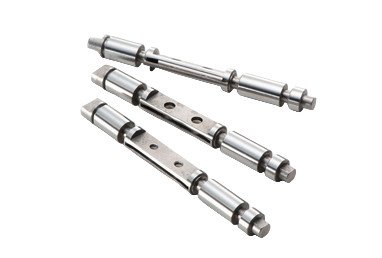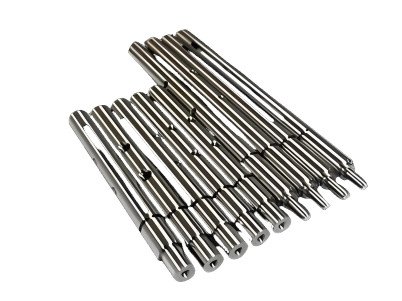The throttle shaft is a critical component in the throttle body of an internal combustion engine, regulating airflow to control engine power output. This article provides a detailed examination of the throttle shaft's design, materials, manufacturing processes, and performance parameters, emphasizing its technical significance in automotive engineering.
Overview of the Throttle Shaft
The throttle shaft is a cylindrical component within the throttle body that supports the throttle valve (or butterfly valve). It rotates to adjust the valve's position, controlling the volume of air entering the engine's intake manifold. This regulation directly influences the air-fuel mixture, impacting engine performance, fuel efficiency, and emissions. The shaft connects to the throttle position sensor (TPS) and, in electronic throttle control (ETC) systems, interfaces with the engine control module (ECM) for precise operation.
Design Specifications and Parameters
The design of a throttle shaft must meet strict mechanical and operational requirements to ensure reliability and performance. Key parameters include diameter, length, material strength, and tolerances. The shaft must withstand rotational forces, resist wear, and maintain alignment within the throttle body.
| Parameter | Description | Typical Values |
|---|---|---|
| Diameter | Determines structural integrity and fit within throttle body | 8–12 mm (depending on throttle body size) |
| Length | Spans the throttle body bore, supporting valve and bearings | 50–100 mm |
| Material | High-strength, corrosion-resistant alloys | Stainless steel (e.g., AISI 304), aluminum alloys |
| Torsional Strength | Resists twisting forces during operation | Yield strength > 400 MPa |
| Surface Finish | Reduces friction and wear | Rz < 0.8 µm |
Materials Selection for Throttle Shafts
Material choice is critical to ensure durability, corrosion resistance, and compatibility with manufacturing processes. Common materials include:
- Stainless Steel (AISI 304/316): Offers excellent corrosion resistance and strength, ideal for harsh engine environments.
- Aluminum Alloys (e.g., 6061-T6): Lightweight with good machinability, used in performance vehicles to reduce weight.
- Brass: Occasionally used for smaller engines due to its machinability and corrosion resistance, though less common in modern applications.
The material must have a high fatigue life to endure cyclic loading, typically designed for a minimum of 10,000 cycles at maximum torque, as seen in high-performance applications.
Manufacturing Processes
Throttle shaft production involves precision manufacturing to achieve tight tolerances and reliable performance. Key processes include:
- CNC Machining: Ensures precise diameter and surface finish. Turning and milling create the shaft's cylindrical shape and keyways for valve attachment.
- Heat Treatment: Enhances hardness and fatigue resistance, particularly for steel shafts. Processes like quenching and tempering are common.
- Surface Finishing: Polishing or grinding achieves low surface roughness (Rz < 0.8 µm), reducing friction and wear against bearings or seals.
- Assembly: The shaft is fitted with the throttle valve, secured via screws or staking, and aligned with bearings or bushings.
Tolerances are typically within ±0.01 mm for critical dimensions to ensure proper fit and function within the throttle body.
Integration with Throttle Body Systems
The throttle shaft operates within the throttle body, interfacing with several components:
- Throttle Valve: A flat, circular plate mounted on the shaft, rotating to regulate airflow. The valve is typically made of aluminum or composite materials to minimize weight.
- Throttle Position Sensor (TPS): Connected to the shaft, it monitors angular position and relays data to the ECM for air-fuel ratio adjustments.
- Bearings or Bushings: Support the shaft, reducing friction and ensuring smooth rotation. Common materials include bronze or polymer-based bushings.
- Actuator (in ETC systems): An electric motor rotates the shaft in drive-by-wire systems, replacing mechanical linkages.
The shaft's design must ensure minimal play and precise alignment to prevent air leaks, which can disrupt engine performance.
Performance Considerations
The throttle shaft's performance directly affects engine efficiency and responsiveness. Key considerations include:
- Rotational Smoothness: Low friction and precise alignment ensure rapid response to driver inputs.
- Durability: The shaft must resist wear from continuous rotation and exposure to heat, fuel vapors, and contaminants.
- Sealing: Proper seals prevent air leaks, maintaining accurate air-fuel ratios. Common seal materials include rubber or PTFE.
In high-performance vehicles, larger throttle bodies (e.g., 60–80 mm diameter) require robust shafts to handle increased airflow and stress.
Maintenance and Common Issues
While throttle shafts are designed for long-term reliability, specific issues can arise:
- Wear in Shaft Bores: Prolonged use can wear the shaft or its bearings, leading to air leaks and erratic idling. Regular inspection and lubrication can mitigate this.
- Corrosion: Exposure to moisture or fuel residues can degrade non-stainless materials, necessitating corrosion-resistant alloys.
- Misalignment: Improper installation or manufacturing defects can cause binding, reducing throttle response.
Maintenance involves cleaning the throttle body, inspecting the shaft for wear, and ensuring proper TPS calibration. Replacement is recommended if wear exceeds 0.05 mm in critical areas.
Testing and Quality Control
Throttle shafts undergo rigorous testing to ensure compliance with performance standards:
- Torsional Testing: Verifies the shaft's ability to withstand rotational forces without deformation.
- Fatigue Testing: Simulates cyclic loading to confirm durability over 10,000 cycles.
- Dimensional Inspection: Uses coordinate measuring machines (CMM) to verify tolerances within ±0.01 mm.
- Environmental Testing: Exposes the shaft to heat, humidity, and corrosive agents to ensure reliability in engine conditions.
Quality control adheres to standards like ISO 9001, ensuring consistency in production.
Applications Across Engine Types
Throttle shafts are used in various internal combustion engines, including:
| Engine Type | Throttle Shaft Requirements |
|---|---|
| Gasoline Engines | Standard shafts with moderate diameters (8–10 mm) for passenger vehicles. |
| Diesel Engines | Larger shafts (10–12 mm) to handle higher torque and airflow in turbocharged systems. |
| Performance Engines | Reinforced shafts with high-strength materials for increased airflow and stress. |
| Small Engines | Compact shafts (6–8 mm) for lawnmowers or motorcycles, often made of brass or aluminum. |

Conclusion
The throttle shaft is a vital component in automotive throttle bodies, enabling precise control of engine airflow. Its design, material selection, and manufacturing processes are critical to achieving optimal performance, durability, and efficiency. By adhering to strict specifications and quality standards, throttle shafts ensure reliable operation across various engine types, from small engines to high-performance vehicles. Understanding these technical aspects is essential for engineers and technicians working to enhance engine performance and reliability.

